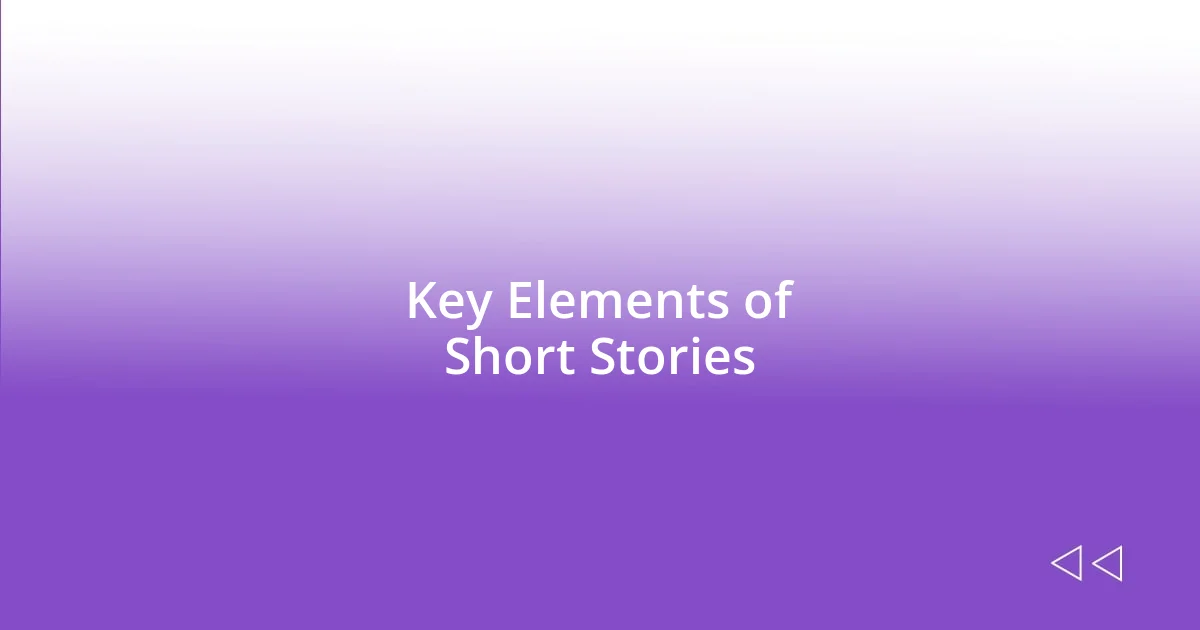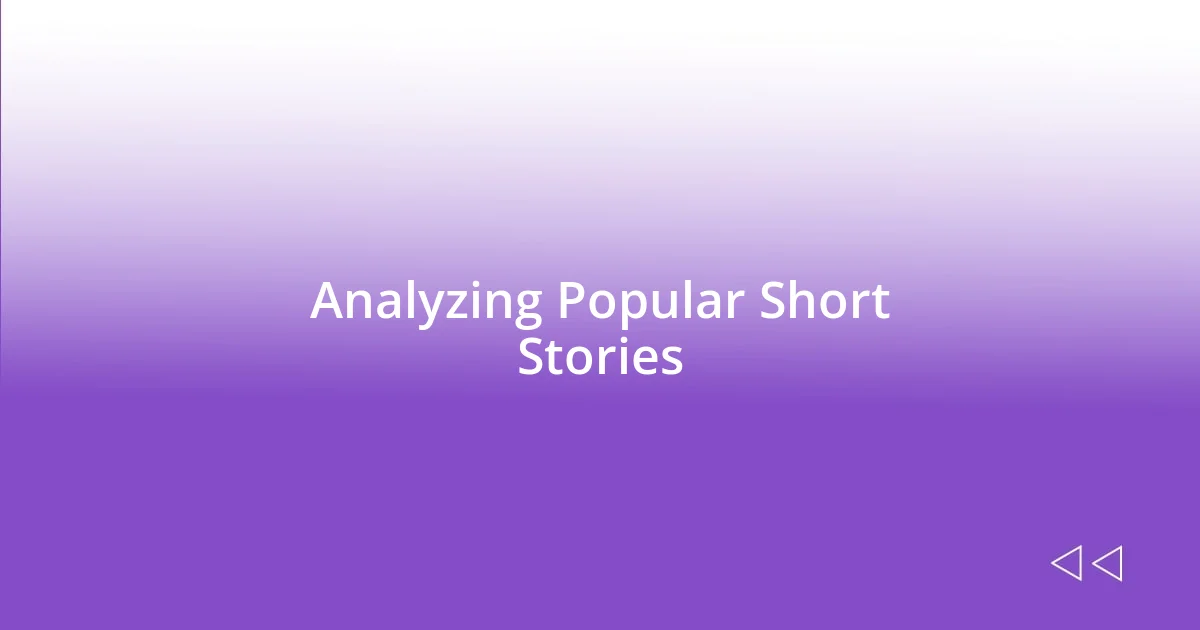Key takeaways:
- Short stories effectively convey complex themes through a compact structure, focusing on central conflicts that engage readers emotionally.
- Key elements of a compelling short story include strong characterization, vivid settings, clear conflict, and meaningful themes, all contributing to the narrative’s impact.
- Sharing short stories benefits from choosing appropriate platforms, engaging with the audience, and practicing delivery to enhance the overall experience and connection.

Understanding Short Stories Basics
Short stories, at their core, are brief narratives that focus on a singular event or character. I recall the first time I immersed myself in a collection of short stories; it was like meeting a series of fascinating individuals, each with a unique tale to tell. Have you ever felt an instant connection to a character in just a few pages? It’s remarkable how a well-crafted story can provoke such strong emotions so quickly.
Understanding the structure of a short story is essential. Typically, they consist of an introduction, rising action, climax, falling action, and resolution—all within a compact format. I remember being amazed after studying this framework; it felt like a secret recipe for the perfect dish. How does a writer manage to convey so much depth in just a few paragraphs?
One of the beautiful aspects of short stories is their ability to focus on one central theme or idea, often leaving the reader with a powerful message or reflection. I’ve found that some of the most memorable short stories linger in my mind long after I turn the last page. Don’t you think it’s incredible how a few carefully chosen words can spark profound discussions or even a change in perspective?

Importance of Short Stories
The significance of short stories lies in their capacity to distill complex themes into a digestible format. I’ve often found that a short story can catalyze introspection much quicker than a novel. This concentrated form allows readers to engage deeply with fundamental human experiences, making each story resonate on different levels.
What strikes me about short stories is their power to explore varied perspectives within a limited word count. I remember reading “The Lottery” by Shirley Jackson; just a few pages in, I felt an unsettling shift in tone that sparked a rollercoaster of emotions. That ability to induce a visceral reaction in such a short span is a unique strength of the genre, often leading to lasting impressions that challenge our interpretations of society.
Moreover, short stories can serve as a launchpad for new writers. I’ve seen many aspiring authors use them as a stepping stone towards longer works, honing their craft and experimenting with style in a more manageable format. It’s this versatility that positions short stories as essential vessels for creativity, inviting bold ideas and exploration without the constraints of length.
| Aspect | Short Stories |
|---|---|
| Emotional Impact | Can instill deep feelings rapidly |
| Perspectives | Explores various viewpoints succinctly |
| Value for Writers | Offers practice ground for aspiring authors |

Key Elements of Short Stories
When it comes to short stories, several key elements contribute to their effectiveness and charm. Each story typically centers around a central conflict that drives the plot forward. I vividly recall reading a story that highlighted a character facing an internal struggle; those pages felt like peeling back the layers of a complex personality. It’s fascinating how a single moment in a character’s life can lead to profound transformations—these conflicts are the heartbeat of the narrative.
Key elements that define a compelling short story include:
- Characterization: Well-developed characters that readers can relate to or find intriguing.
- Setting: A vivid backdrop that enhances the mood and supports the plot.
- Conflict: A central issue or challenge that engages readers and propels the narrative.
- Theme: The underlying message or insight that resonates long after the story ends.
- Resolution: The conclusion that ties up the narrative, often with a twist that lingers in the reader’s mind.
As I dive deeper into short stories, I realize how the pacing must be just right. Each sentence contributes to building tension or developing characters. I remember getting lost in a story where the clever dialogue and swift pacing left me breathless, as if I were racing alongside the characters. There’s something elegantly powerful about distilling emotions and experiences into a handful of pages, and recognizing these elements truly enriches my reading and writing experience.

Techniques for Writing Short Stories
One effective technique I’ve found invaluable when writing short stories is the focused use of imagery. By choosing just a few striking images, I can evoke strong emotions and create a vivid setting without overwhelming the reader with details. For instance, I once penned a story centered around a sunset at the beach; instead of describing every element of the scene, I zeroed in on the interplay of darkening clouds and shimmering waves. This simplicity not only painted a picture but also served as a metaphor for the character’s emotional journey.
Pacing is another crucial technique that I cannot stress enough. In short stories, every word counts, so finding the right rhythm can transform the reader’s experience. I vividly recall writing a piece where I deliberately slowed down during a pivotal moment, allowing the tension to linger. It felt like stretching time itself; I could almost hear the heartbeat of my character while readers leaned in closer, anticipating what would happen next. Isn’t it fascinating how manipulating pacing can turn an ordinary moment into something gripping?
Finally, I’ve discovered that dialogue is a powerful tool for revealing character and advancing the plot. During my writing sessions, I often experiment with the balance between dialogue and action. I remember a short story in which the main character’s sarcastic banter not only showcased her personality but also subtly hinted at her underlying loneliness. How often do we find ourselves using humor to mask deeper feelings? This interplay makes dialogue not just functional but also rich with layers, captivating readers and drawing them deeper into the narrative.

Analyzing Popular Short Stories
In analyzing popular short stories, I often discover that the emotional resonance of a piece can significantly rely on characterization. I remember reading a story where the protagonist’s vulnerability pierced right through the pages, evoking empathy in me. Isn’t it intriguing how a well-crafted character can make us reflect on our own life experiences, almost as if we’re walking in their shoes?
The settings in these stories, too, deserve attention. I once encountered a tale set in a bustling city that utilized vivid descriptions of the crowded streets and honking cars to mirror the protagonist’s chaotic mind. It made me think—how often does the environment shape our internal conflicts? These carefully curated backdrops not only provide context but also deepen our connection to the characters’ journeys.
Conflict often serves as the engine of a short story, and in analyzing successful works, I’ve seen how a tension-filled moment can lead to a powerful resolution. I remember a twist ending in a story that flipped my expectations on their head and left me in awe. Isn’t it fascinating how a masterfully executed twist can linger in our minds, prompting us to reconsider the entire narrative? The interplay of conflict and resolution allows us to explore complex themes together, vying for deeper understandings and emotional truths.

Tips for Sharing Short Stories
When it comes to sharing short stories, one effective tip I’ve learned is to choose the right platform. Depending on the story’s tone and audience, platforms like social media, blogs, or local open mic nights can significantly affect how the piece is received. I recall sharing a light-hearted story at a community event, where the live audience’s laughter made me realize just how much the atmosphere can amplify a story’s impact. Isn’t it amazing how the setting can change the energy of a narrative?
Engaging with your audience during the sharing process is another key tip. I often invite questions or feedback after my readings, which not only fosters a sense of connection but also sparks rich discussions. One time, after sharing a deeply personal story, a listener approached me and shared their own similar experience, creating an unexpected bond. This made me wonder—how many connections can storytellers forge simply by being open and inviting dialogue?
Lastly, practicing your delivery can enhance the experience for both you and your audience. I remember preparing for a reading by experimenting with different tones and pacing, almost like an actor stepping into a role. The first time I read a story with expressive emphasis on pivotal moments, I noticed how the audience seemed to hang onto my every word. Isn’t it fascinating how the way we tell a story can breathe life into the words on the page? This realization truly transformed my approach to sharing my stories, making each session feel more like a shared experience.














